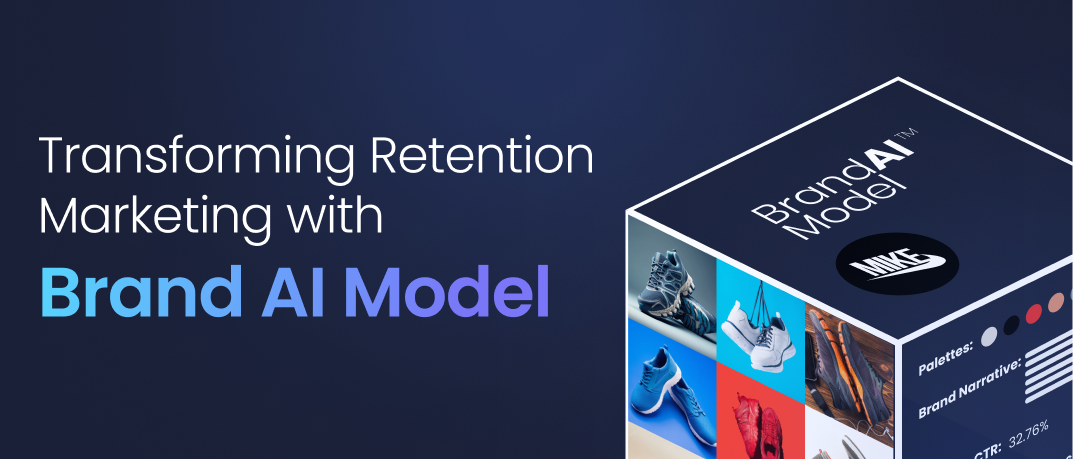Transforming Retention Marketing with Brand AI Model

Achieving contextual personalization based on brand identity, design, and audience preferences is a formidable challenge. However, the novel Brand AI Model revolutionizes this process by integrating large language models (LLMs) and brand-specific attributes to generate highly personalized brand creatives.
The Essence of the Brand AI Model
The Brand AI Model, as developed by Contlo, leverages foundational models like DALL-E, Stable Diffusion, and GPT, enhancing them with brand tonality, identity, and past campaigns to produce tailored creatives. The model’s architecture consists of three main components:
- Brand Attribute Encoder (BAE): Encodes textual and visual brand attributes using transformer-based and CNN architectures, respectively. This dual encoder architecture effectively captures complex relationships and dependencies in textual inputs through self-attention mechanisms, and hierarchical patterns in visual inputs through convolutional layers.

- Fine-tuned Foundational Models (FFM): Adapts pre-trained models to brand-specific data, ensuring brand alignment. The fine-tuning process involves pre-training on a large dataset of generic creatives followed by training on a smaller, brand-specific dataset. Techniques such as layer-wise learning rate annealing and knowledge distillation enhance the retention of brand-specific information.

- Performance Feedback Module (PFM): Uses reinforcement learning, specifically Proximal Policy Optimization (PPO), to iteratively refine the model based on real-world campaign performance metrics like click-through rates, impressions, and conversions.

Ensuring Brand Consistency and Engagement
The Brand AI Model excels in producing creatives that are not only visually and contextually aligned with brand identity but also resonate with individual user preferences. By incorporating a continuous feedback loop, the model adapts to changing user behaviors and campaign objectives, enhancing its performance over time. This approach ensures that the generated creatives maintain high levels of brand consistency and personalization, leading to increased user engagement and satisfaction.
Experimental Validation
In rigorous experiments, the Brand AI Model significantly outperformed traditional generative methods. The dataset comprised 10,000 creatives from 50 different brands across various industries, split into 80% training and 20% testing sets. Key metrics included:
- Brand Consistency Score (BCS): 42% improvement
- Personalization Score (PS): 33% improvement
- Click-Through Rates (CTR): 27% increase
These results underscore the model’s ability to generate engaging, brand-consistent creatives that drive higher user engagement. The significant improvements in BCS, PS, and CTR highlight the model’s effectiveness in maintaining brand identity while personalizing content for individual users.
Practical Applications and Benefits
The practical applications of the Brand AI Model are vast. By generating contextually personalized brand creatives for emails, SMS, images, and social media assets, brands can ensure that every piece of content aligns with their identity and resonates with their audience. This leads to more effective marketing campaigns, higher engagement rates, and ultimately, increased brand loyalty and sales.
Additionally, the continuous feedback loop mechanism allows brands to adapt their creatives based on real-time performance data, ensuring that their marketing strategies remain relevant and effective. This adaptability is crucial in a constantly changing digital landscape where consumer preferences and behaviors can shift rapidly.
Future Directions
Looking ahead, the potential of the Brand AI Model can be expanded by incorporating additional brand attributes, exploring new input modalities like audio and video, and utilizing more advanced reinforcement learning techniques. Integrating user-generated content and real-time social media data could further enhance contextual personalization.
Future research directions include the exploration of additional brand attributes and input modalities such as audio and video, as well as more advanced reinforcement learning techniques to further enhance the model’s performance and adaptability. Additionally, investigating the integration of user-generated content and real-time social media data could provide valuable insights for generating even more personalized and contextually relevant creatives.
Conclusion
The Brand AI Model represents a significant advancement in retention marketing, enabling brands to achieve unprecedented levels of contextual personalization. This model sets a new standard for creating engaging and brand-aligned marketing content by harnessing the power of LLMs and integrating continuous feedback mechanisms.
Incorporating the Brand AI Model into your marketing strategy can transform how you connect with your audience, ensuring that every creative perfectly aligns with your brand’s identity and objectives. Embrace the future of personalized marketing and stay ahead in the competitive digital landscape.
For more information on how Contlo’s Brand AI Model can revolutionize your marketing strategy, visit Contlo’s Brand AI Model.
Read our research paper on Brand AI Model here.

